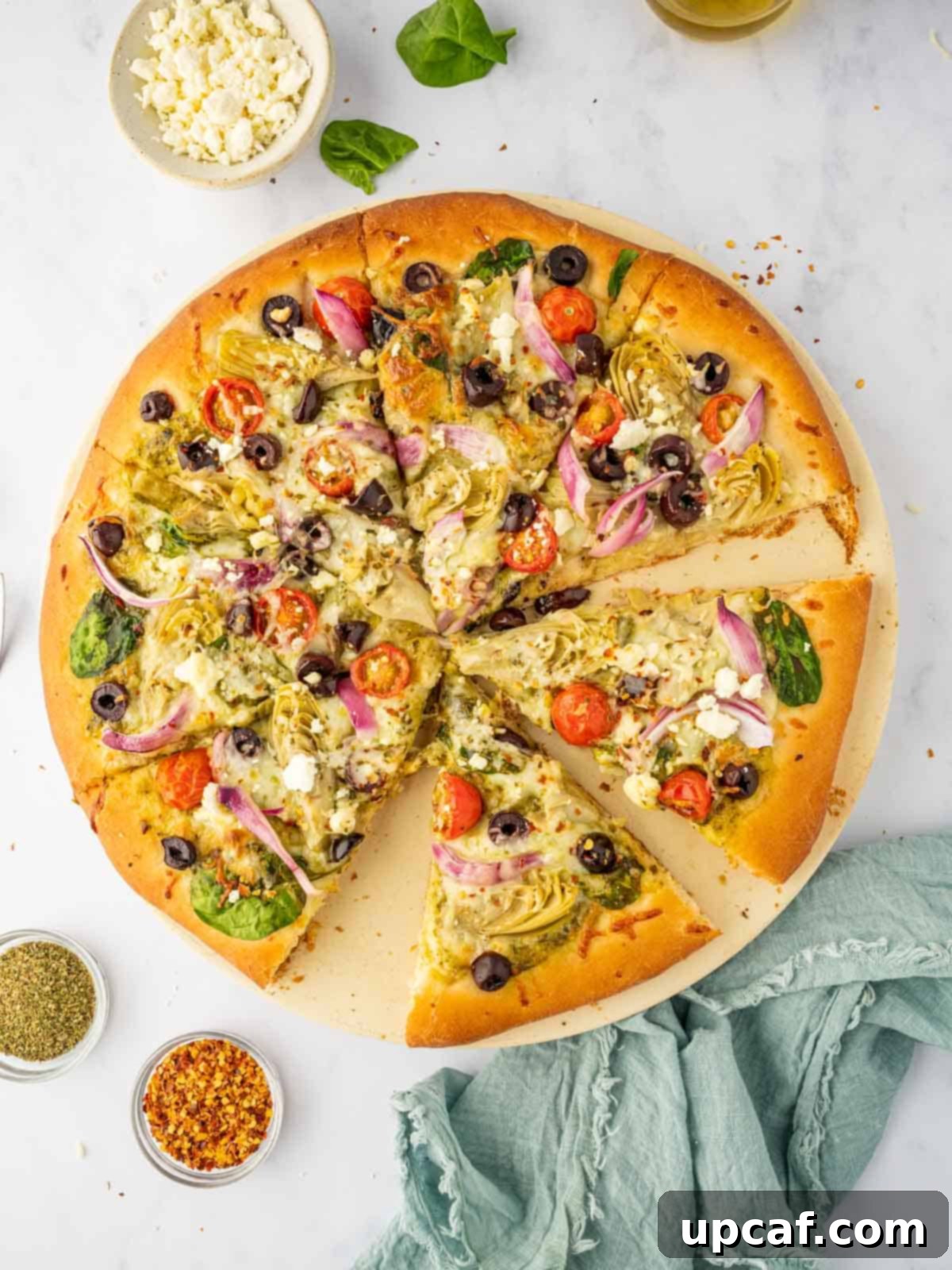Transform your weeknight dinner into an unforgettable Mediterranean escape with this exquisite Homemade Mediterranean Pizza recipe. Forget expensive takeout; prepare to delight your senses with a restaurant-quality, crispy crust loaded with fresh, vibrant ingredients like tangy feta, robust Kalamata olives, sweet cherry tomatoes, tender artichoke hearts, and nutrient-rich spinach. This Greek-inspired pizza is more than just a meal; it’s a celebration of flavors, offering a perfect blend of savory, salty, and earthy notes in every single bite. Whether you choose to craft your dough from scratch or opt for the convenience of store-bought, this recipe makes gourmet pizza accessible and incredibly rewarding. Get ready to impress your family and friends with a culinary masterpiece that brings the sun-drenched shores of the Mediterranean right to your kitchen.
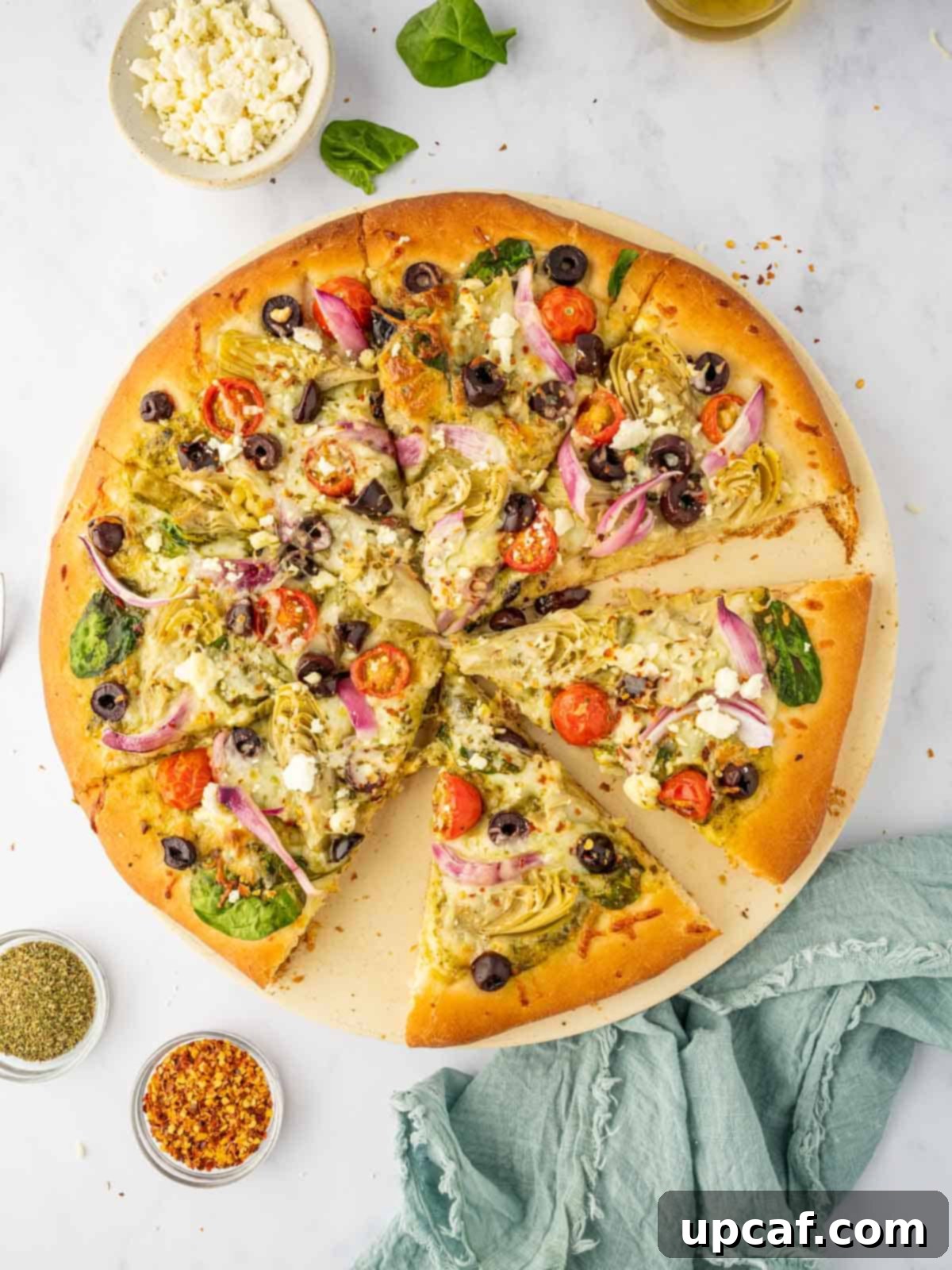
There’s nothing quite like the satisfaction of biting into a perfectly crafted pizza, especially one that marries the classic comfort of homemade crust with the bold, aromatic flavors of the Mediterranean. Our Mediterranean Pizza stands out with its irresistible crispy crust, a testament to proper baking techniques that rival your favorite pizzeria. It’s generously topped with a medley of fresh vegetables, briny Kalamata olives, and crumbled feta cheese, delivering a symphony of tastes and textures. This recipe is designed to be both straightforward for beginners and satisfying for seasoned home cooks. It offers the flexibility to use a homemade pizza dough recipe or a convenient store-bought option, allowing you to tailor the effort to your schedule. Perfect for a cozy family dinner, a lively gathering with friends, or simply a treat for yourself, this Mediterranean pizza promises a delightful culinary journey.
If you’re a connoisseur of authentic Mediterranean cuisine, we highly recommend exploring some of our other cherished recipes. Dive into the rich flavors of our Mediterranean Lamb Chops, savor the succulent Mediterranean Stuffed Chicken, or enjoy the refreshing zest of our Lemon Herb Mediterranean Pasta Salad. Each dish is crafted to transport you to the vibrant culinary landscape of the Mediterranean.
Why You’ll Adore This Mediterranean Pizza Recipe
Effortlessly Delicious & Family-Friendly: This isn’t just a recipe; it’s an invitation to create lasting memories. Get everyone involved in the pizza-making process, from kneading the dough to sprinkling toppings. It’s a fantastic activity for all ages, fostering connection and the joy of cooking together. Plus, its universally appealing flavors ensure it’s a hit with even the pickiest eaters.
Unbeatably Crispy Crust: The secret to a truly outstanding pizza lies in its crust. Our method, especially when utilizing a preheated pizza stone, guarantees a crust that’s wonderfully golden brown and audibly crispy with every bite. This restaurant-style texture elevates your homemade pizza experience, making it feel truly gourmet.
Hassle-Free Customization: We understand that life can be busy. That’s why this recipe offers ultimate flexibility. You can embark on the rewarding journey of making your pizza dough from scratch, enjoying the fresh aroma and texture of homemade. Alternatively, for those days when time is of the essence, a quality store-bought dough works beautifully, ensuring a delicious meal without the fuss.
Bursting with Vibrant Flavors: Every ingredient chosen for this Mediterranean pizza contributes to a harmonious and delightful flavor profile. From the salty tang of feta and Kalamata olives to the fresh sweetness of cherry tomatoes and the earthy notes of artichokes and spinach, each bite is a delightful explosion of tastes. The basil pesto base adds a fragrant, herbaceous depth that perfectly complements the Mediterranean toppings.
Nutrient-Rich and Wholesome: Beyond its incredible taste, this pizza is packed with wholesome ingredients. Fresh vegetables provide essential vitamins and fiber, while feta and mozzarella offer calcium and protein. It’s a balanced meal that doesn’t compromise on flavor, making it a guilt-free indulgence.
Perfect for Any Occasion: Whether it’s a casual weeknight dinner, a festive weekend gathering, or a special occasion, this Mediterranean pizza fits right in. Its elegant presentation and crowd-pleasing flavors make it an ideal centerpiece for any table. It’s a dish that feels special yet is surprisingly easy to execute.
Mediterranean Pizza Ingredients

Crafting Your Homemade Pizza Dough:
Making your own pizza dough is a rewarding experience that adds an unparalleled freshness to your pizza. This recipe yields enough for one generously sized 12-inch pizza. However, if time is a constraint, a quality fresh or frozen store-bought dough can be an excellent shortcut without sacrificing flavor.
All-Purpose Flour: The foundation of our dough. Sifting the flour beforehand ensures a lighter, airier texture and helps prevent lumps, leading to a smoother, more consistent dough.
Granulated Sugar: More than just a sweetener, sugar plays a crucial role in activating the yeast, helping the dough rise beautifully. It also contributes to the golden-brown color and subtle sweetness of the crust.
Fine Sea Salt: Essential for enhancing the overall flavor of the pizza dough. Salt not only seasons the dough itself but also regulates the yeast’s activity, contributing to a controlled rise and improved texture.
Instant Yeast: The leavening agent responsible for giving our pizza dough its characteristic rise and soft, chewy texture. Ensure your yeast is fresh for optimal results; old yeast may fail to activate properly.
Baking Powder: While yeast provides the primary rise, a small amount of baking powder adds an extra lift, contributing to a slightly crisper and lighter crust, especially beneficial for home ovens.
Light Neutral Oil (Canola or Vegetable): Oil adds richness and tenderness to the dough, making it more pliable and easier to handle. It also contributes to a slightly crisper crust and helps prevent it from drying out during baking.
Whole Fat Yogurt (Plain Greek Yogurt Recommended): This unexpected ingredient is a game-changer! Whole fat yogurt adds incredible moisture, a subtle tang, and a wonderful creaminess to the dough, resulting in a more tender and flavorful crust. It also aids in fermentation.
Lukewarm Whole Milk: Milk provides liquid for the dough while also adding richness and contributing to a softer texture compared to water. Ensure it’s lukewarm (around 105-115°F or 40-46°C) to properly activate the yeast without killing it.
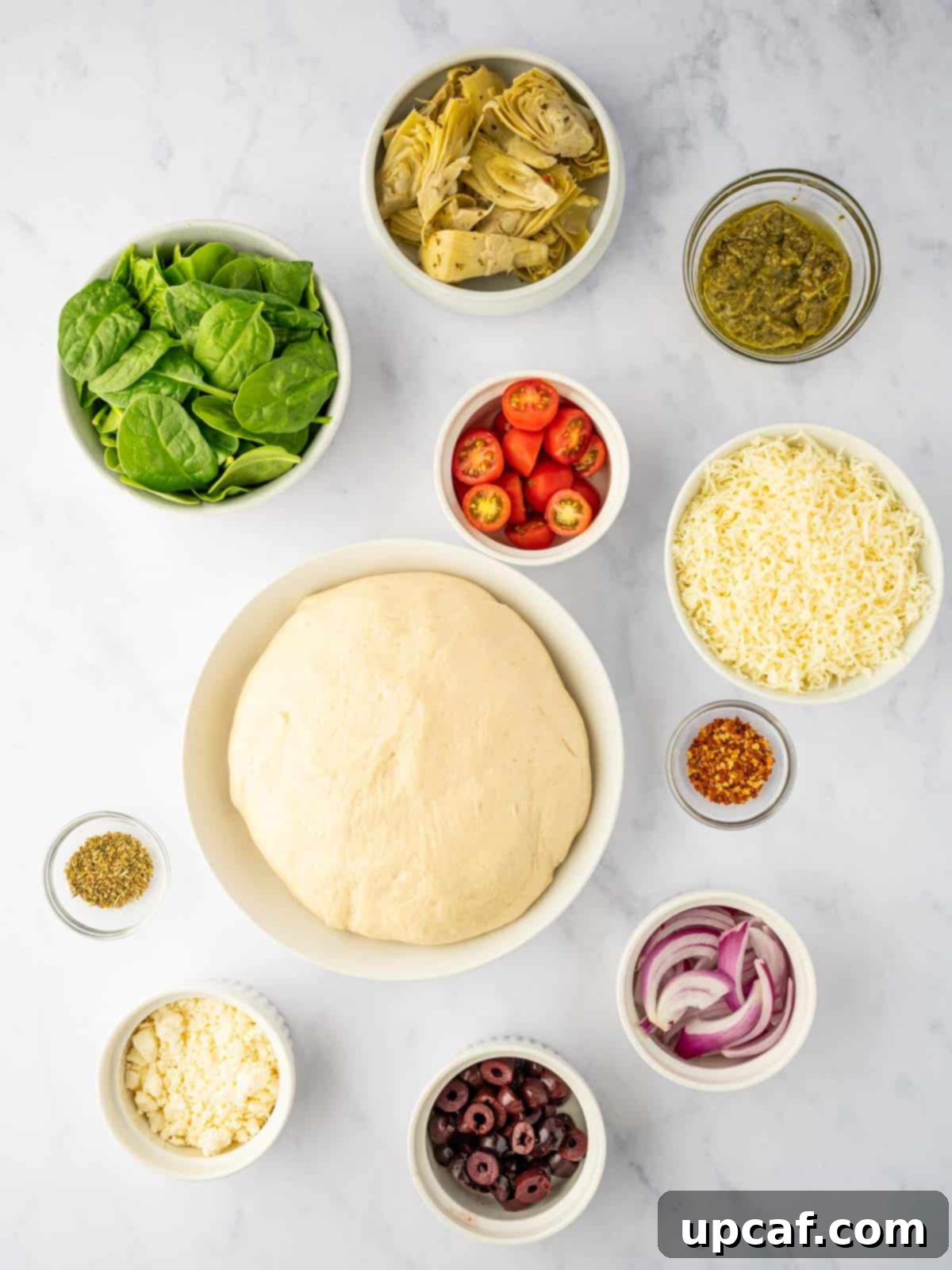
Fresh Mediterranean Toppings:
The beauty of Mediterranean pizza lies in its fresh, vibrant toppings. Each ingredient is carefully selected to contribute to a balanced and unforgettable flavor profile.
Basil Pesto: This vibrant green sauce forms the flavorful base of our pizza, infusing it with a burst of fresh basil, garlic, pine nuts, and Parmesan. If pesto isn’t your preference, a drizzle of high-quality olive oil or a rich marinara sauce makes excellent alternatives, providing different but equally delicious foundations.
Shredded Mozzarella Cheese: The quintessential pizza cheese, mozzarella delivers that classic melty, stretchy, and cheesy goodness we all crave. For variety, consider other excellent melting cheeses such as provolone, sharp cheddar, or even a creamy Gouda to impart different flavor notes.
Quartered Artichoke Hearts: Artichokes add a delightful earthy flavor and a tender yet slightly fibrous texture. Ensure they are well-drained to avoid making the pizza soggy. For an extra layer of flavor or as a substitute, roasted red peppers or sun-dried tomatoes offer a sweet and smoky contrast.
Fresh Baby Spinach: A touch of freshness and vibrant color comes from baby spinach. It wilts beautifully on the pizza, adding a delicate, slightly sweet flavor. Arugula, added after baking for a peppery kick, or finely chopped kale, can be used as nutritious alternatives.
Halved Cherry Tomatoes: These small, juicy tomatoes burst with concentrated sweetness when baked, providing a lovely counterpoint to the savory and salty elements. Grape tomatoes can be used interchangeably.
Sliced Kalamata Olives: The hallmark of Mediterranean flavor, Kalamata olives offer a distinctively briny, rich, and slightly fruity taste. Their deep purple color also adds visual appeal. If you prefer, green olives for a sharper brine or black olives for a milder flavor can also be used.
Thinly Sliced Red Onion: Red onion adds a crisp texture and a sweet, mildly pungent flavor that mellows beautifully upon baking. White or yellow onions can be substituted, but red onions are often preferred for their slightly sweeter profile and vibrant color.
Crumbled Feta Cheese: This tangy, salty, and slightly creamy cheese is a star ingredient, providing a sharp contrast and a quintessential Greek flavor to the pizza. Its crumbles distribute perfectly, ensuring a burst of flavor in every bite.
Italian Seasonings: A blend of dried oregano, basil, thyme, and rosemary, Italian seasonings tie all the Mediterranean flavors together with their aromatic herbs. You can use a pre-made blend or mix your own for customized intensity.
Crushed Red Pepper Flakes: For those who enjoy a bit of warmth and subtle heat, crushed red pepper flakes are a fantastic addition. Adjust the amount according to your preference to achieve the perfect level of spice.
How To Make Mediterranean Pizza: A Step-by-Step Guide
Creating this gourmet Mediterranean pizza at home is a straightforward process, broken down into two main stages: preparing the perfect dough and assembling and baking your masterpiece.

For the Homemade Pizza Dough:
Step 1: Combine Ingredients: In a large mixing bowl, whisk together all the dry ingredients for the dough: sifted all-purpose flour, sugar, salt, instant yeast, and baking powder. In a separate bowl, combine the wet ingredients: canola or vegetable oil, whole fat yogurt, and lukewarm whole milk. Gradually add the wet mixture to the dry ingredients. If using an electric stand mixer, attach a dough hook and mix on low speed for 2-4 minutes until the ingredients are thoroughly combined and a cohesive dough forms. The dough should be slightly sticky but pull away from the sides of the bowl.
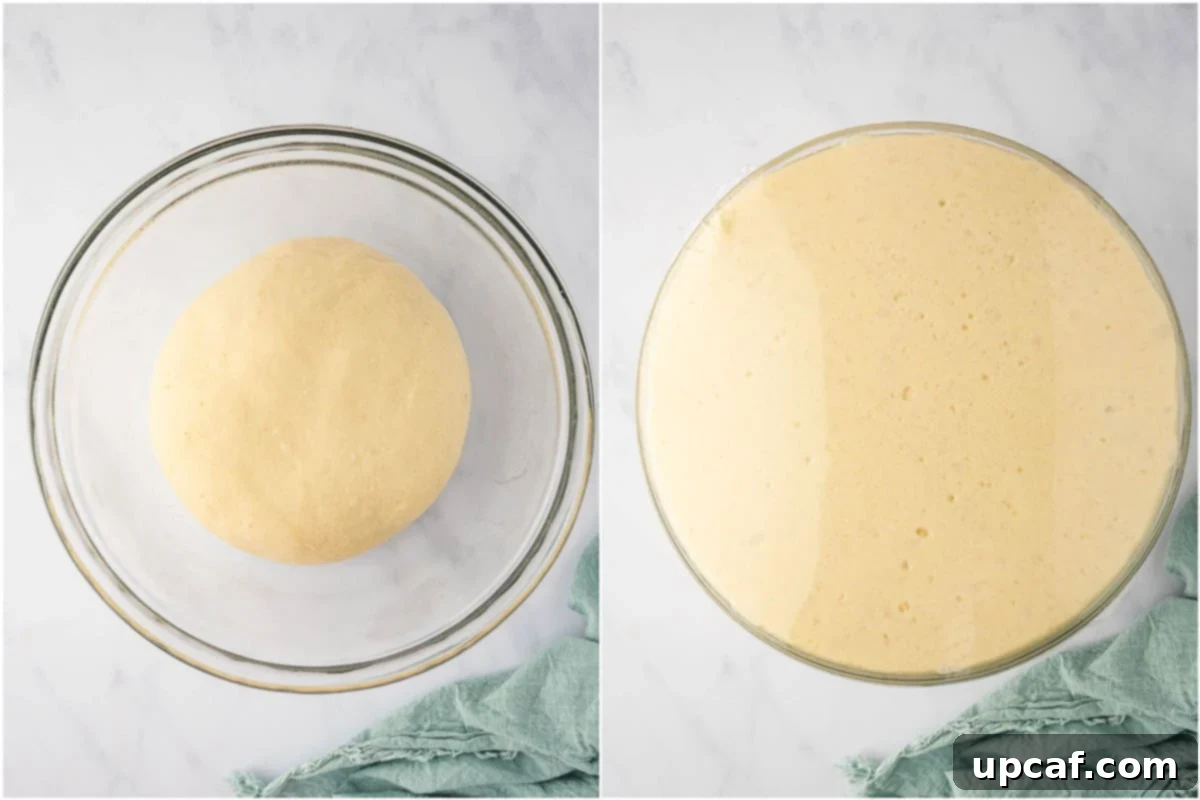
Step 2: Knead and First Rise: Lightly flour a clean cutting board or work surface. Carefully remove the dough from the mixing bowl and knead it gently with your hands for about 1-2 minutes until it becomes smooth and elastic. Shape it into a neat ball. Lightly spray the mixing bowl with oil spray, then return the dough ball to the bowl, turning it once to coat. Cover the bowl tightly with plastic wrap or a clean kitchen towel and let it rest in a warm, draft-free place for approximately 1 hour, or until it has doubled in size.
Step 3: Punch Down and Second Rest: Once the dough has risen significantly, gently punch it down to release the accumulated air. Transfer the dough back to your floured cutting board. Knead it lightly again to reshape it into a ball. Cover it once more with a kitchen towel or plastic wrap and allow it to rest for an additional 10 minutes. This second rest helps the dough relax, making it much easier to roll out.
For the Pizza Assembly and Baking:
Step 1: Preheat Oven and Pizza Stone: Position an oven rack in the middle of your oven and place your pizza stone on it. Preheat the oven to a high temperature of 450°F (230°C). Allow the pizza stone to heat up for at least 30-45 minutes while your oven preheats; this is crucial for achieving a perfectly crispy crust.
Step 2: Roll Out the Dough: On a lightly floured surface, use a rolling pin to carefully roll out your pizza dough into a circular shape, aiming for approximately a 12-inch diameter. Strive for an evenly thin crust to ensure consistent baking and crispiness. If the dough springs back, cover it and let it rest for another 5 minutes before continuing.

Step 3: Apply the Pesto Base: Carefully transfer the rolled-out dough to a piece of parchment paper or a well-floured pizza peel. Spread the basil pesto sauce evenly over the surface of the dough, leaving a small, clean border (about 1/2 to 1 inch) around the edges for the crust.
Step 4: First Layer of Mozzarella: Sprinkle approximately 1 cup of shredded mozzarella cheese evenly over the pesto sauce. This initial layer of cheese acts as a barrier, preventing the crust from becoming soggy from the vegetable toppings, and also ensures cheesy goodness throughout.
Step 5: Add the Mediterranean Toppings: Artfully arrange the quartered artichokes, fresh baby spinach, halved cherry tomatoes, sliced Kalamata olives, and thinly sliced red onion over the mozzarella layer. Distribute these ingredients evenly to ensure every slice gets a taste of all the delicious components. Finally, scatter the crumbled feta cheese over the vegetables, adding its characteristic tangy flavor.
Step 6: Second Layer of Mozzarella & Seasoning: Sprinkle the remaining ½ cup of shredded mozzarella cheese over the toppings. This helps to hold everything in place and ensures a beautiful melted cheese finish. Generously sprinkle Italian seasonings and, if desired, crushed red pepper flakes over the entire pizza for an extra layer of aroma and flavor.
Step 7: Transfer to Oven: Using a pizza peel or by carefully sliding the parchment paper, gently transfer the prepared pizza onto the preheated pizza stone in the hot oven. Be quick and confident to avoid losing heat.
Step 8: Bake to Perfection: Bake the pizza for 15-17 minutes. Keep a close eye on it; the pizza is ready when the crust is golden brown, the cheeses are melted and bubbling, and the toppings are slightly caramelized. Cooking times may vary slightly based on your oven.
Step 9: Cool Slightly: Once baked, carefully remove the pizza from the oven using your pizza peel. Transfer it to a cutting board or wire rack and allow it to cool for about 5 minutes. This resting period allows the cheese to set and the flavors to meld, making for cleaner slices and preventing burnt mouths.
Step 10: Slice and Serve: Slice the pizza into your desired portions using a sharp pizza cutter. Serve immediately and enjoy the incredible taste of your homemade Mediterranean creation!

Tips for Crafting the Perfect Homemade Mediterranean Pizza
Achieving pizzeria-quality results at home is easier than you think with these expert tips:
Prioritize Fresh, High-Quality Ingredients: The foundation of any exceptional Mediterranean dish lies in the freshness of its components. Opt for ripe, vibrant cherry tomatoes, firm artichoke hearts, succulent Kalamata olives, and fragrant basil for your pesto. Fresh ingredients truly elevate the overall taste and nutritional value of your pizza.
Crucial Oven Preheat: Never underestimate the importance of a properly preheated oven, especially when using a pizza stone. Ensuring your oven and stone reach 450°F (230°C) and hold that temperature for at least 30 minutes before baking is key. This intense initial heat is what creates that coveted crispy crust and perfectly cooked toppings.
Roll the Dough Thin for Crispiness: For a truly crispy crust reminiscent of authentic Mediterranean pizzerias, aim to roll your pizza dough as thinly as possible without tearing it. A thinner crust bakes faster and achieves a superior crispness. Using a lightly floured surface and a rolling pin, or even your hands, can help achieve this desired thickness. A pizza peel dusted with flour or cornmeal will make transferring the thin dough to the hot stone much easier.
Avoid Overloading with Toppings: While it’s tempting to pile on every delicious ingredient, restraint is key for a Mediterranean pizza. Too many toppings can lead to a soggy crust and uneven cooking. A moderate, even distribution of each ingredient allows their individual flavors to shine through and ensures every bite is balanced.
Strategic Topping Distribution: Ensure that all your chosen toppings are spread evenly across the pizza. This not only guarantees a consistent flavor profile in every slice but also aids in even cooking. Distribute cheeses and vegetables thoughtfully, leaving a small border for the crust.
Adjust Red Pepper Flakes to Taste: The amount of crushed red pepper flakes is entirely up to your personal preference. Start with a smaller amount and add more if you desire a spicier kick. You can even sprinkle it on individual slices after baking if not everyone enjoys heat.
Allow for Cooling Time: Once your Mediterranean pizza emerges from the oven, resist the urge to slice into it immediately. Allowing it to cool for about 5 minutes on a cutting board or wire rack is essential. This short resting period allows the molten cheese to set, preventing toppings from sliding off and making for cleaner, more manageable slices. It also prevents accidental burns from scorching hot cheese.
Consider a Pizza Screen or Perforated Pan: If you don’t have a pizza stone, a pizza screen or a perforated pizza pan can also help achieve a crispier crust by allowing air circulation underneath the dough during baking. Preheat these along with your oven for best results.
Don’t Forget the Dough Rest: When making homemade dough, don’t rush the rising and resting periods. These steps are crucial for developing flavor and texture. A properly rested dough will be easier to work with and yield a much better crust.
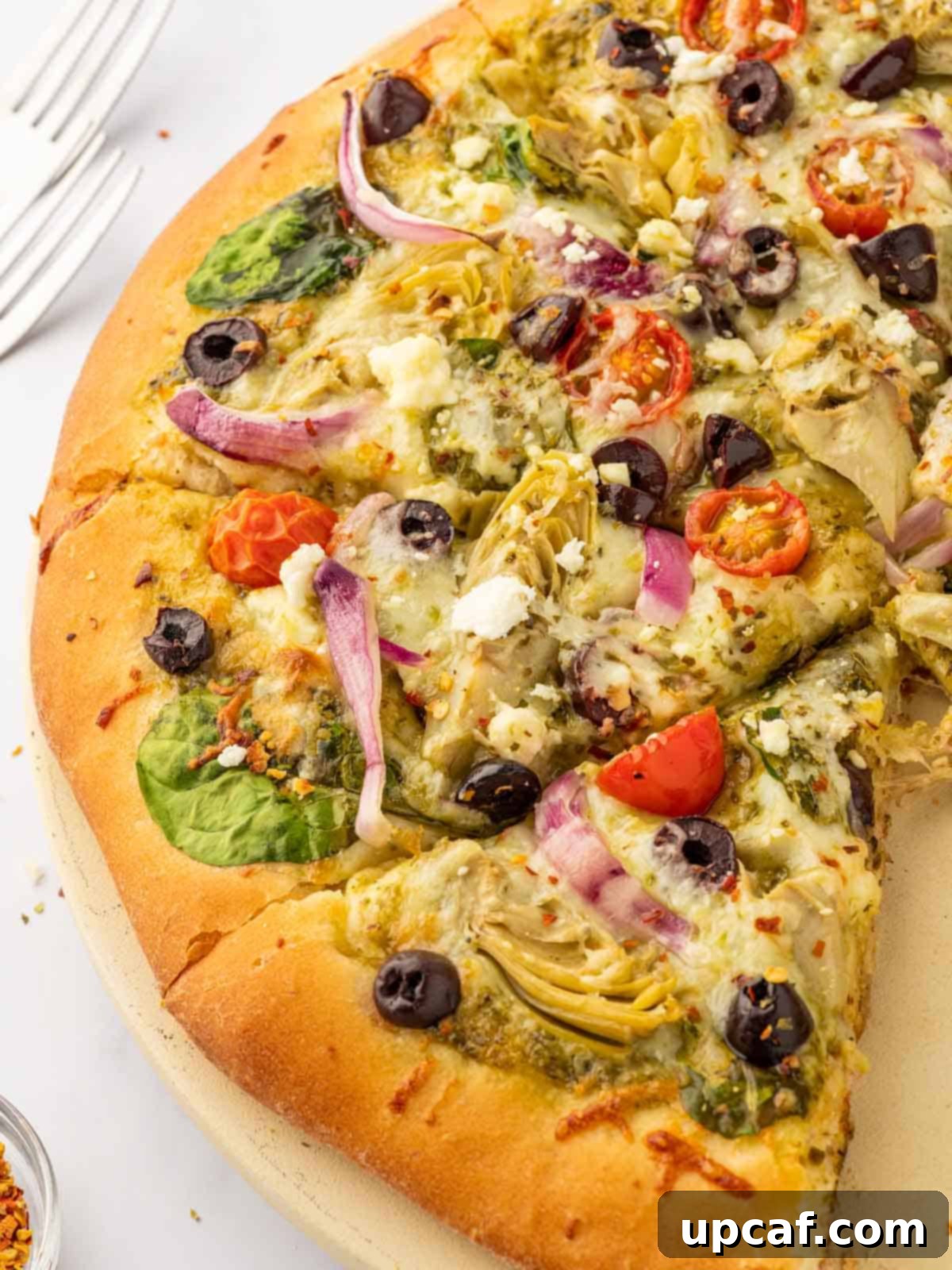
Frequently Asked Questions About Mediterranean Pizza
Absolutely! Using store-bought pizza dough is a fantastic time-saver and perfectly acceptable for this recipe. While homemade dough offers a unique flavor and texture, a good quality store-bought option allows you to enjoy this delicious pizza even on busy weeknights. Just be sure to let it come to room temperature before rolling it out.
While a pizza stone is highly recommended for achieving that coveted ultra-crispy crust, it’s not strictly necessary. You can still make a delicious Mediterranean pizza using a heavy-duty baking sheet or a dedicated pizza pan. The key is to preheat the pan along with your oven to ensure the crust starts cooking immediately upon contact with the hot surface, preventing sogginess.
Several factors contribute to a crispy, non-soggy crust. First, ensure your oven and pizza stone (or pan) are thoroughly preheated to a high temperature. Second, avoid overloading the pizza with too many wet toppings. A thin layer of cheese under the wetter ingredients can also create a barrier. Finally, don’t skimp on the baking time; ensure the bottom of the crust is golden brown.
Leftover Mediterranean pizza can be stored in an airtight container or wrapped tightly in plastic wrap in the refrigerator for up to 3-4 days. For the best reheating results, use an oven or air fryer. A few minutes at 350°F (175°C) in the oven or air fryer will crisp up the crust and melt the cheese beautifully, making it taste almost as good as fresh.
Yes, you can freeze leftover pizza. For best results, allow the pizza to cool completely. Wrap individual slices tightly in plastic wrap, then place them in an airtight freezer bag or container. It can be stored in the freezer for up to 1-2 months. Reheat from frozen in a preheated oven or toaster oven until warmed through and crispy.
While this Mediterranean pizza is certainly a meal in itself, it pairs wonderfully with a fresh, light side salad to round out the meal. Some excellent choices include a vibrant Grilled Chicken Strawberry Salad, a refreshing Watermelon Cucumber Feta Salad, or a classic Mozzarella Caprese Salad. A simple green salad with a lemon-herb vinaigrette would also be perfect.
This Mediterranean pizza is inherently vegetarian. To make it vegan, you would need to substitute the mozzarella and feta cheeses with plant-based alternatives and ensure your pesto recipe is dairy-free (or use a dairy-free pesto, or olive oil as a base). Many excellent vegan cheeses and pestos are available that can perfectly mimic the flavors and textures.
Absolutely! This recipe can be easily adapted for a gluten-free diet by using a store-bought gluten-free pizza crust or by preparing your own favorite gluten-free pizza dough recipe. The vibrant Mediterranean toppings remain the same, ensuring a delicious and accommodating meal for everyone.

Discover More Delicious Pizza Recipes
If you loved this Mediterranean masterpiece, we invite you to explore more of our innovative and flavorful pizza creations:
- Cauliflower Pizza: A fantastic low-carb, gluten-friendly option that doesn’t compromise on flavor or satisfaction. Perfect for a lighter take on your favorite dish.
- Mediterranean Veggie Pizza: Another vibrant vegetable-packed pizza, ideal for showcasing the fresh produce and wholesome flavors of the Mediterranean diet.
Elevate your homemade pizza experience with our stunning Homemade Mediterranean Pizza with Feta and Olives. Featuring a perfectly crispy crust, the irresistible tang of feta cheese, the rich brininess of Kalamata olives, and a harmonious blend of fresh Mediterranean vegetables, this pizza is truly a slice of culinary artistry. We hope you find immense joy in all the recipes we share, especially this delightful Mediterranean Pizza. We encourage you to try it, savor every bite, leave a star rating, and share your delicious creations with your friends and family!
If you try this recipe and love it, please take a moment to leave a star rating and a comment below. We cherish your feedback! Don’t forget to use my hashtag to share your mouthwatering recreations with me on Instagram so I can see and celebrate your culinary success! Also, make sure to follow Cookin’ With Mima on FACEBOOK, INSTAGRAM, and PINTEREST for all my latest recipes, cooking tips, and social updates. Happy cooking!

Homemade Mediterranean Pizza
Homemade Mediterranean Pizza with feta boasts a mouthwatering, crispy crust that elevates your homemade pizza to a restaurant-style experience. Made with a homemade or store-bought crust, this Greek Pizza Recipe is generously topped with fresh spinach, tender artichokes, juicy tomatoes, briny olives, crumbled feta, and gooey mozzarella cheese.
Ingredients
For Pizza Dough
- 1 ½ cups All-purpose flour, sifted
- 2 ¼ teaspoons sugar
- ¼ teaspoon salt
- 1 tablespoon instant yeast
- ¾ teaspoon baking powder
- 1 ½ tablespoons canola or vegetable oil
- ¼ cup whole fat yogurt
- ½ cup whole milk, lukewarm
- Oil spray (for bowl)
For the Pizza
- 1 portion of pizza dough (yields one 12-inch pizza)
- 2 tablespoons basil pesto
- 1 ½ cups mozzarella cheese, shredded
- 1 cup quartered artichokes, liquid drained
- 1 cup baby spinach
- ⅓ cup cherry tomatoes, halved
- ⅓ cup Kalamata olives, sliced
- ½ cup red onion, thinly sliced
- ½ cup crumbled feta cheese
- 1 teaspoon Italian seasonings
- ½ teaspoon crushed red pepper flakes (optional)
Instructions
For Pizza Dough
- Mix the dry ingredients (flour, sugar, salt, yeast, baking powder) in one mixing bowl and the wet ingredients (oil, yogurt, lukewarm milk) in another. Gradually add the wet mixture to the dry and combine well using an electric stand mixer with a dough hook for 2-4 minutes on low speed, until a cohesive dough forms.
- Remove the dough from the bowl and sprinkle some flour on a cutting board. Knead the dough lightly with your hands to form a nice ball shape. Spray the bowl with oil spray and return the dough. Cover and let the dough rest for 1 hour in a warm place until doubled in size.
- Once the dough has risen, gently punch it down to release the air. Remove the dough again from the bowl and transfer to a cutting board. Sprinkle with some flour and knead gently to reshape it into a ball.
- Cover the dough with a kitchen towel or plastic wrap and let it rest for 10 more minutes. This helps the dough relax, making it easier to roll out.
For the Pizza
- Preheat the oven to 450°F (230°C) with the pizza stone inside, allowing it to heat up for at least 30-45 minutes.
- Roll out the pizza dough to about a 12-inch size using a rolling pin, ensuring it is evenly thin.
- Carefully transfer the rolled dough onto a pizza peel dusted with flour or cornmeal (or parchment paper). Spread the basil pesto sauce evenly in the center of the pizza dough, leaving a small border around the edges for the crust.
- Sprinkle about 1 cup of shredded mozzarella cheese over the pesto sauce, covering it evenly.
- Top the pizza with quartered artichokes, baby spinach, halved cherry tomatoes, sliced Kalamata olives, and thinly sliced red onion, distributing them evenly over the pizza. Then, scatter the crumbled feta cheese. Spread the remaining ½ cup of mozzarella cheese over the toppings.
- Sprinkle Italian seasonings and crushed red pepper flakes (if using) evenly over the toppings for added flavor.
- Gently transfer the prepared pizza onto the preheated pizza stone in the oven.
- Bake the pizza for 15-17 minutes, or until the cheeses are melted, bubbling, and the edges of the pizza are golden brown and crispy.
- Once done, remove the pizza from the oven and allow it to cool for about 5 minutes on a cutting board or wire rack.
- Slice the pizza into desired portions and serve immediately.
Notes
- Use Fresh Ingredients: The quality of your ingredients, especially the tomatoes, olives, and basil, will greatly impact the final taste of your pizza. Opt for fresh and ripe produce.
- Preheat Your Oven Thoroughly: Ensure your oven is preheated to 450°F (230°C) for at least 30 minutes, especially with a pizza stone, to achieve that crispy crust.
- Roll the Dough Thin: Roll your pizza dough as thin as possible for a crispy crust. A pizza stone or pizza peel can significantly help with transfer.
- Don’t Overload with Toppings: While it’s tempting to pile on the toppings, less is often more with Mediterranean pizza. A moderate amount of each ingredient will allow their flavors to shine and prevent a soggy crust.
- Evenly Distribute Toppings: For a consistent flavor profile and even cooking, make sure all ingredients are spread evenly across the pizza.
- Adjust Red Pepper: Customize the amount of crushed red pepper flakes according to your preferred level of spice.
- Allow to Cool: Once out of the oven, give your pizza a few minutes (about 5) to cool slightly. This allows the cheese to set and makes slicing and serving much easier and safer.
- Alternative Crusts: Feel free to use store-bought pizza dough or a gluten-free crust for convenience or dietary needs.
- Storage: Store leftovers in an airtight container in the fridge for up to 4 days. Reheat in the oven or air fryer for best results.
Nutrition
Carbohydrates: 28g |
Protein: 20g |
Fat: 16g |
Saturated Fat: 7g |
Polyunsaturated Fat: 1g |
Monounsaturated Fat: 5g |
Cholesterol: 43mg |
Sodium: 1382mg |
Potassium: 244mg |
Fiber: 4g |
Sugar: 8g |
Vitamin A: 1372IU |
Vitamin C: 7mg |
Calcium: 355mg |
Iron: 2mg
